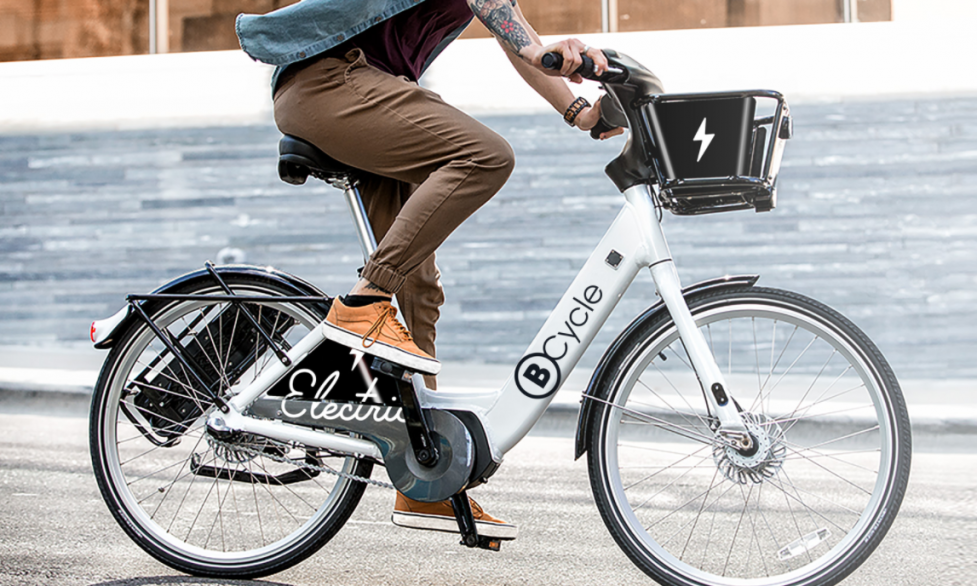



When Santa Cruz relaunched its bikeshare system in June 2023, the city faced a familiar challenge: how to operate a sustainable service while keeping bikes secure and available to riders. At the center of this effort was BCycle, the selected bikeshare operator (now part of Bicycle Transit System), with a team of 12 people locally, led by their General Manager Kyle Klein and Operations Manager Jérôme Trichard.
“We started with 100 stations, 1,000 docks, and 500 e-bikes,” explains Trichard.
BCycle indeed operates a fleet with docking stations, to deliver a reliable service, keeping the bike parked tidy. The previous dockless service, which operated between 2018 and 2020, had unfortunately too many bikes ending up in the ocean or the river, or scattered everywhere in town.
The BCycle service quickly became part of Santa Cruz’s mobility landscape. The University of California, Santa Cruz (UCSC), located on a steep hill overlooking the city and Monterey Bay, emerged as a key partner and user. “Students rely on bikes to move between buildings,” says Trichard. “They can’t drive from one class to another, so they either walk or ride.” As the campus is quite large, riding is a good option. The university subsidizes annual passes so students pay only $32.75 per year, which makes the system very accessible.” With nearly 40 stations on campus, UCSC accounts for almost half of the entire network.
However, the geography also brought operational challenges. “Every evening, students use the bikes to ride downhill back to the city,” Trichard explains. “But in the morning, few ride back uphill. That means our team spends a lot of time rebalancing bikes back up the hill. We even hired a night technician specifically to bring bikes back so students could find them the next day.”
The early months also revealed another serious obstacle: theft and vandalism. Like many Californian cities, Santa Cruz has a significant homeless population, and stolen bikes quickly became a daily concern. “We lost at least 50 bikes in the beginning,” recalls Trichard. “Some people figured out how to pull bikes out of the docks, and we were constantly searching them in shelters and the forest. At one point, I was spending entire days just looking for missing bikes.”
Initially, the team used Tile Bluetooth trackers, but results were inconsistent. “The problem with Tile is that it only works if someone with a phone passes nearby. Often, the location you got was actually the phone’s location, not the bike’s. We could spend hours looking and never find the bike,” says Trichard.
BCycle also hardened its docking stations, adding some poles that reduced the snatching of bikes from the docks. “However, that solution couldn’t be physically added to every station due to some city restrictions. Some stations stayed at risk.”
This changed when BCycle Santa Cruz partnered with Connected Cycle to equip its fleet with professional-grade GPS trackers and fleet management software, early 2025. “Connected Cycle changed our lives,” says Trichard. “Our record is finding a missing bike in just 15 minutes from the moment we receive a service ticket. With Tile, that was impossible.”
The results speak for themselves. Before, the operations team was recovering five to seven bikes per day. With Connected Cycle trackers, that number has dropped to about two per week. “Since installing Connected Cycle trackers, we haven’t permanently lost a single bike,” emphasizes Trichard. “The system gives us real-time data, so we can act immediately before someone has time to tamper with the GPS.”
The new solution also simplified logistics. With real-time access to bike battery levels, technicians can plan rebalancing more efficiently, reducing wasted trips. “During the summer, when students are away, we can plan our battery swapping routes based on battery levels, Having access to battery status is a big help. But once the semester starts, most of our effort is spent moving bikes back up the hill to the university”, says Trichard.
Another major advantage is durability. Unlike Tile devices, which required replacing coin cell batteries every two to three months, Connected Cycle trackers are powered directly from the bike system. “With Tile, if the battery died, you lost location tracking and risked losing the bike. Now, with Connected Cycle, we don’t have to worry about that anymore. It’s a huge reduction in workload,” Trichard explains.
Beyond the technology, Trichard believes the approach adopted by the operations team has helped strengthen community relations. “We’ve always tried to be respectful when recovering bikes,” he says. “Even when dealing with homeless individuals riding bikes without subscribing, we are polite and avoid confrontation. I like to think that people now respect BCycle’s assets more because of that. Connected Cycle helps us act quickly and discreetly, so we can solve problems without escalation.”
Looking ahead, BCycle Santa Cruz plans to continue expanding its network into neighboring towns like Capitola and Live Oak. For Trichard, Connected Cycle is essential to making that growth sustainable. “The difference is night and day. With Connected Cycle, we have peace of mind. We know where our bikes are, we recover them quickly, and we save a tremendous amount of time. It has truly transformed our operations.”
For BCycle Santa Cruz, Connected Cycle is more than a tracking solution—it is the backbone of efficient fleet management in a city committed to sustainable mobility.